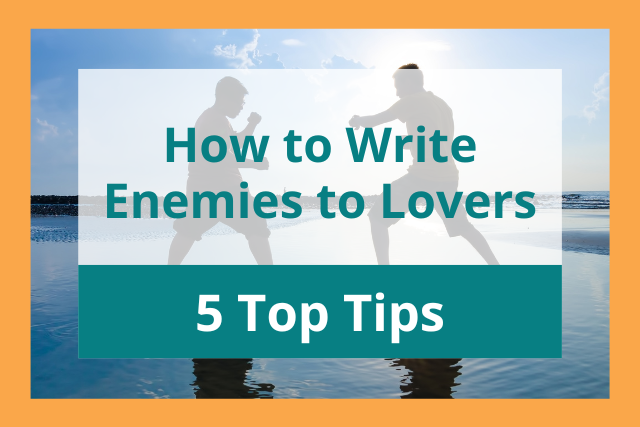
One of the most popular tropes in genre fiction right now is the enemies to lovers trope.
After all, love and hatred are two sides of the same coin. There’s something exhilarating about the idea of falling in love with someone you’re supposed to hate.
But how do writers pull off such a drastic transformation and make it convincing to readers?
If you’re working on a novel or short story that includes this trope, you’ve come to the right place.
This article will explain what the enemies to lover trope is, discuss some well-known examples, and give you our five top tips for writing this trope in your own work.
What Is an Enemies to Lovers Story?
The term “enemies to lovers” refers to a specific type of love story in which two characters start out as adversaries but end up in a romantic relationship by the end of the story.
The “enemies” stage of this trope can take many forms, from a harmless rivalry to a deadly feud. Here are some examples of what enmity might look like in different genres:
- In a fantasy novel, it might be a princess falling in love with a thief
- In a Western, it might be an outlaw falling in love with a bounty hunter
- In a sports novel, it might be a soccer player falling in love with a player on her rival team
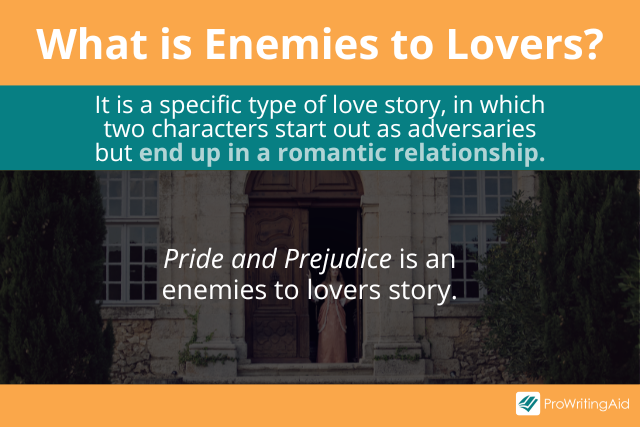
Often, the two characters make false assumptions about each other at the beginning of the story, which fuels their mutual hatred. Once they let go of their prejudices and overcome their misconceptions, they realize the other person isn’t as terrible as they initially thought.
Many readers love the enemies to lovers trope because these stories create a sense of hope and redemption.
Great Enemies to Lovers Examples
Let’s take a look at some examples of great enemies to lovers stories in English literature.
Example 1: Pride and Prejudice by Jane Austen
Enemies to lovers might be a trendy trope right now, but it’s a tale as old as time. Plenty of classic stories use this trope, including Pride and Prejudice.
In this 19th-century novel of manners, Elizabeth Bennet initially dislikes Mr. Darcy. She sees him as arrogant and snobbish and assumes he looks down on her because of his higher social class.
Over the course of the book, Elizabeth and Darcy realize their initial assumptions about each other were incorrect. They have to overcome their pride and prejudice in order to end up together.
Example 2: The Hating Game by Sally Thorne
In The Hating Game, Lucy and Joshua have an ongoing rivalry while working for the same book publishing company. When they start competing for the same promotion, their enmity rises to a whole new level.
But as they continue to spend time competing for the job, they start questioning their real feelings for each other. It takes a tantalizingly long time for them to realize that maybe, just maybe, they don’t hate each other as much as they think they do.
Example 3: These Violent Delights by Chloe Gong
These Violent Delights is a young adult retelling of the Shakespeare play Romeo and Juliet, which is arguably one of the most famous enemies to lovers stories of all time.
Gong’s retelling is set in 1920s Shanghai, where the blood feud between two rival criminal gangs has left the city in turmoil.
Juliette Cai, the heir of the Scarlet Gang, needs to work together with Roma Montagov, the heir of the White Flowers, in order to save their city—if their competing allegiances don’t get in the way.
Example 4: Six of Crows by Leigh Bardugo
The enemies to lovers relationship is just one subplot of many in Six of Crows, but it’s a particularly fun one.
Nina is a Grisha with magical powers. Matthias is a Drüskelle who has been raised to hunt all Grisha, since his society considers them an abomination.
Matthias captures Nina and keeps her hostage on a ship as he sails back to his own nation. But when they end up shipwrecked on a deserted island, they have to put their differences aside and depend on each other for survival.
Example 5: The Wrath and the Dawn by Renee Ahdieh
The Wrath and the Dawn is a retelling of the classic story A Thousand and One Nights, in which a king marries a new woman every day and kills her every morning.
In this version, Shahrzad decides to marry the Caliph and prevent him from killing her by telling him a story every day and leaving him on a cliffhanger every night. Then, she plans to kill him in revenge for the lives he’s taken.
But as she spends more time with him, she finds herself slowly falling for him—especially once she realizes he might not be the monster she thinks he is.
7 Steps on How to Write Enemies to Lovers Story Arcs
Now that we’ve looked at some great examples of stories that feature this trope, it’s time to write one of your own!
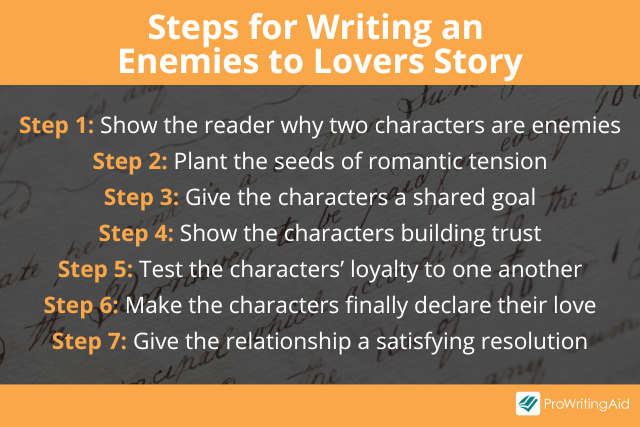
Here’s our step-by-step guide to writing an enemies to lovers arc.
Step 1: Show the Reader Why Two Characters Are Enemies
Showing the enmity between your two characters is the first step in building an enemies to lovers arc.
The keyword here is “show.” If you write the sentence, “Sam and Alex really, really hated each other,” your readers probably won’t find that very convincing. You have to depict their hatred in action.
For example, if your story features a princess falling in love with a thief, set up the conflict between them early on. Show the thief stealing from the royal family. Show the princess harshly punishing criminals arrested by her guards.
The more clearly we can see the two characters’ enmity, the more invested we’ll feel watching their relationship evolve.
Step 2: Plant the Seeds of Romantic Tension
Make it clear from the get-go that your two characters notice each other, in terms of both physical appearance and personality traits.
For example, maybe Sam notices the way Alex secretly reads cheesy romance novels when no one else is looking. Or the way Alex loves saying hello to strangers in the street. Or the fact that Alex’s hair always smells like strawberries.
Maybe Alex notices that Sam would do anything to protect her family. Or the songs Sam listens to over and over. Or the tiny dimple at the corner of Sam’s mouth.
Keep it subtle. The two characters are still enemies—they shouldn’t be waxing poetic about the other person’s perfect lips or bulging muscles.
Just give us a few small, understated moments to set the stage for romantic attraction later on in the story.
Step 3: Give the Characters a Shared Goal
In order for two people to fall in love, they have to spend a significant amount of time together. But if you take two enemies and ask them whether or not they want to spend time together, they’ll probably laugh in your face.
That’s why you need to give your two characters a common goal. If they need to work together, they’ll be forced to spend time together—and voila, you’ve set the stage for romance.
There are many different types of shared goals you can use. Here are just a few examples:
- Their boss forces them to collaborate on a project
- One of them gets hired by the other
- They need to travel together to the same place
- They need to solve a mystery together
- They find out about a common enemy they need to defeat
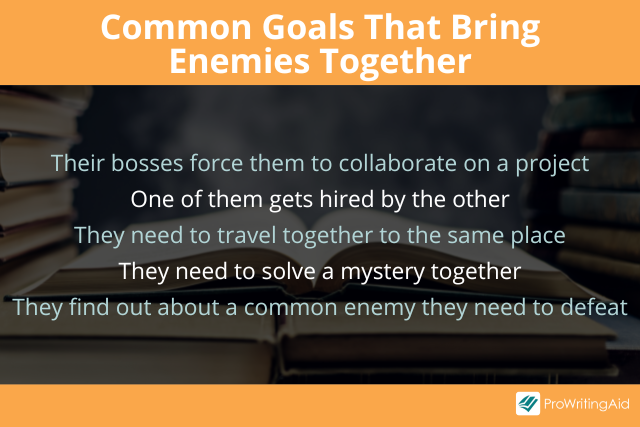
Step 4: Show the Characters Building Trust
No relationship can succeed without a foundation of trust.
It’s important for these two characters to start trusting each other, in spite of their rocky start.
They should reach a point where they each trust the other person to keep their secrets, support them in their goals, and perhaps even protect them with their life.
Sometime during this stage of the story, the two characters realize they have feelings for each other, but they’re too afraid to voice them.
Maybe they think a relationship can’t possibly work because of their histories. Or maybe they think the other person genuinely hates them.
Still, trust is starting to bloom, even if it remains unspoken for now.
Step 5: Test the Characters’ Loyalty to One Another
You can’t write a great love story that hurtles straight toward “happily ever after” with no obstacles along the way. Well, you can, but your readers might get bored.
That’s why most enemies to lovers arcs include an obstacle that tests the two characters’ loyalty to one another, just when they’ve decided they can trust each other.
There are many different forms this obstacle can take. For example:
- Maybe a different character, like one of the characters’ family members, finds out about this budding romance and tries to put a stop to it
- Maybe a secret comes out, which one of the two characters has been hiding
- Maybe the two characters find out they can’t both achieve their goals—one of them will have to fail in order for the other to succeed
Give your readers the heart-wrenching moment when it seems like the entire relationship is falling apart before it’s even begun.
Step 6: Make the Characters Finally Declare Their Love
Up until now, the two characters have managed to slowly fall in love without actually admitting how they really feel about each other.
Now, it’s time to force their hand. At this point, they must declare their love for each other, or else risk losing everything.
This is the breakthrough moment that your readers have been waiting for—the moment when both characters finally confess the feelings they’ve been fighting for so long.
Step 7: Give the Relationship a Satisfying Resolution
After the declaration of love, the two characters have to decide what role they want to play in each other’s lives.
Most of the time, the story ends with the two characters in a romantic relationship. Sometimes they reveal their relationship to their families, move in together, or even get married.
Of course, not every enemies to lovers story has a happy ending. Maybe your two characters need to part ways and might never see each other again.
You can choose whether you want to give your readers a heartwarming ending or a heart wrenching one. Just make sure you wrap up enough loose threads to create a satisfying resolution.
5 Tips for Writing an Enemies to Lovers Story
If you want to write a fantastic enemies to lovers story, there are some other things you need to keep in mind.
Here are our five top tips for executing this trope well.
Tip 1: Tie the Romance to Character Development
Character development is critical for writing a good story.
One reason why many readers love the enemies to lovers trope is because it forces both characters to grow and change throughout the story. After all, the person the protagonist was at the beginning of the book would never have fallen in love with her sworn enemy.
For example, if you’re writing a fantasy story about a monster hunter falling in love with a monster, you can make the hunter strongly prejudiced against all monsters at the beginning. As they get to know their love interest, they might let go of their misconceptions and begin to grow as a person.
The more closely you can tie the romance to the character’s transformation, the more satisfying their arc will feel.
Tip 2: Give the Characters a Strong Reason for Being Enemies
At the beginning of the story, it’s crucial to show the reader why the two characters hate each other.
If you’re writing a love story between a princess and a thief, maybe a band of thieves killed the princess’s family when she was younger. That gives her a personal reason to hate her love interest, at least until she comes to terms with the fact that it’s not his fault her family died.
If you’re writing a story with a more mundane setting, the enmity might not have life-or-death stakes, but you still need to include convincing reasons. Simply saying, “Alex didn’t like the color of Sam’s hair,” or “Sam thought Alex was annoying” isn’t going to cut it.
Here are some possible reasons for two people to be enemies:
- A deep-rooted misunderstanding
- A war or feud
- Societal prejudices
- Conflicting goals
- A competition that only one character can win
Tip 3: Steer Clear of Toxic Relationship Dynamics
Writing enemies to lovers comes with potential pitfalls.
One such pitfall is the possibility of accidentally writing a toxic relationship. The two characters should start out as enemies, but they shouldn’t derive joy from hurting each other.
Make sure you’re not writing a relationship about two characters who bully each other or put each other down. Nobody should be in a relationship with anyone who abuses them, either verbally or physically.
As a writer, it’s important for you to be aware of what an unhealthy dynamic looks like, so you don’t accidentally glamorize a toxic relationship.
Tip 4: Create Moments of Genuine Connection
Every romance requires genuine connection between two characters. But this is even more important in an enemies to lovers romance, since they have more hurdles to overcome.
Here are some ways you can create moments of genuine connection between your two characters:
- Let them confess their fears and vulnerabilities
- Give them shared hobbies or personality traits
- Have them protect each other in moments of danger
- Have them do thoughtful things for each other
- Create parallels in their backstories or family situations
Tip 5: Use a Grammar Checker
It’s hard to keep readers immersed in your story if your writing includes spelling errors or grammar mistakes.
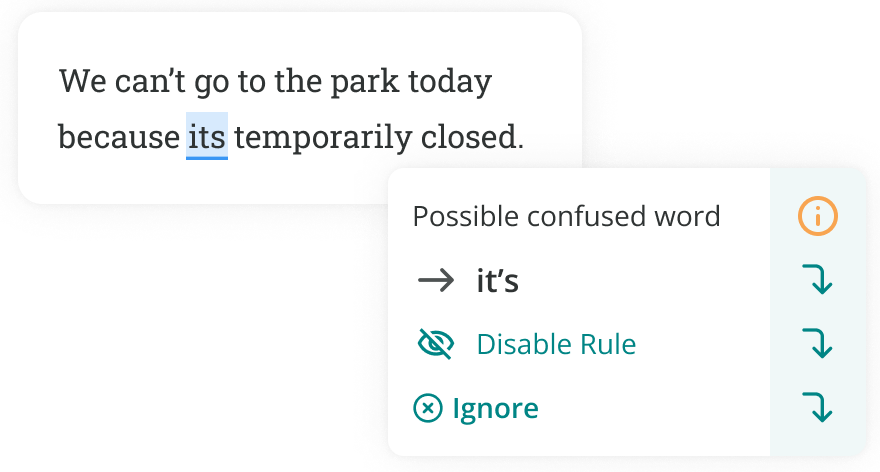
ProWritingAid can help you make sure your writing is clear and error-free. The software suggests improvements that you might not spot on your own, such as typos, punctuation errors, weak adjectives, repetitive words, and so much more.
Good luck, and happy writing!

